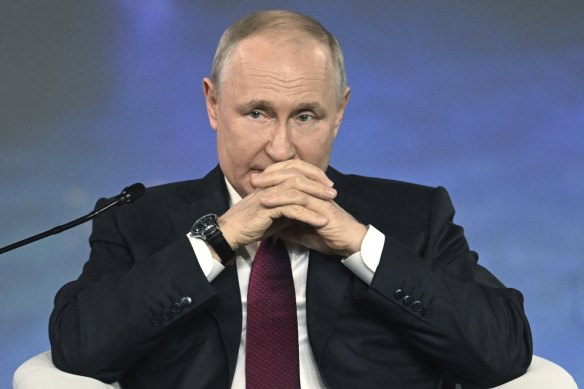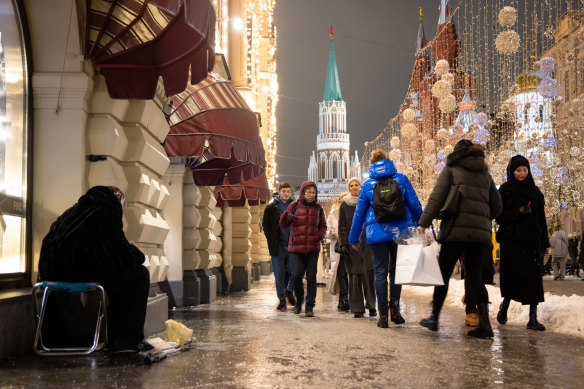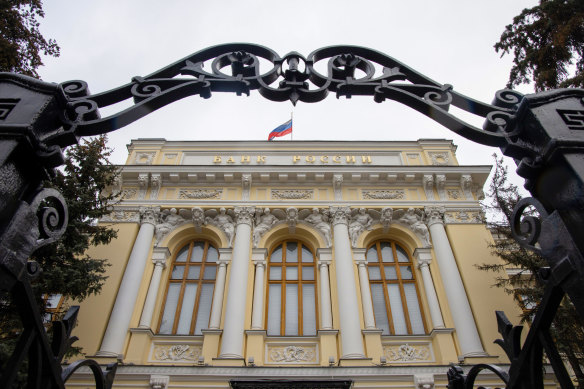This was published 1 year ago
Opinion
Putin’s choice: The war or his people
Stephen Bartholomeusz
Senior business columnistThe European Union has imposed its 12th package of sanctions against Russia, days after Russia’s central bank raised its key interest rate for the fifth time since July. There’s a connection between those events.
The Bank of Russia lifted its policy rate to a staggering 16 per cent last Friday in response to inflation running at a rate of about 7.5 per cent.

The West is putting the squeeze on Russia’s economy.Credit: AP
Soaring prices for goods and services – egg prices, for instance, are up 40 per cent this year – and (despite capital controls and the forced repatriation of companies’ foreign exchange holdings) a 20 per cent depreciation of the rouble against the US dollar, reflect the strains that the war in Ukraine and the West’s sanctions are inflicting on Russia’s economy.
While Vladimir Putin continues to describe the war as a “special military operation”, Russia is now operating a wartime economy.
Next year it is budgeting to spend about $160 billion on its military, more than three times its defence budget before the invasion of Ukraine and, at about 6 per cent of GDP, nearly 40 per cent of the government’s entire budgeted expenditures.
With Western companies and their capital and expertise fleeing Russia, a significant proportion of its diminished industrial capacity now devoted to supplying the war effort and the previous financial and trade sanctions cutting the economy off from Western goods and services, domestic demand is overwhelming the capacity of the economy to supply goods and services to the non-military sectors of the economy.
A shortage of labour is adding to the inflationary pressures. Not only have hundreds of thousands of former civilian employees been redeployed to Ukraine and more shifted to war-related production, but around 700,000 Russians have fled the country since the war began.
Russia’s economic lifeline has been its oil and gas revenues.
It took some time for the G7 (plus Australia) sanctions on Russian oil to bite, which enabled Russia to not only generate a lot of income during the early phase of the war but, as the sanctions and the $US60 a barrel price cap on its oil exports started to gain traction, assemble its “grey armada” of ageing tankers that has increasingly enabled it to circumvent the sanctions.
That has, however, come at a cost. The acquisition and operating costs of the fleet it has assembled, and the longer shipping routes to the Chinese and Indian buyers who have replaced European buyers as Russia’s major customers, have added, according to US Treasury, about $US36 a barrel to Russia’s costs.

The impact of the war on the standard of living for Russians is becoming increasingly obvious.Credit: Bloomberg
China and India, as the only substantial buyers of Russian oil, have also been able to demand significant discounts, further reducing the net proceeds from Russia’s oil sales.
In that sense, even though more than half Russia’s oil exports in recent months have been at prices above the cap, the sanctions have worked to materially reduce Russia’s revenues from them. Russia’s central bank has said that the revenues of the country’s largest oil and gas producers were 41 per cent lower in the first nine months of this year than for the same period of 2022.
The new package of sanctions, apart from new EU and G7 measures designed to ban imports of Russian diamonds which, if effective, could deprive Russia of about $6.5 billion a year of revenue, include efforts to tighten the sanctions on oil exports.
The EU will more closely monitor the sales of tankers to third countries, with more detailed documentation required and tougher action planned against third countries helping Russia evade the sanctions.
Senior US Treasury department officials are in Europe this week to discuss further efforts to tighten the enforcement of the price caps.
If the EU, US and others are able to squeeze Russia’s oil revenues even harder, it would add to the pressure on Russia’s economy and its ability to both sustain the war effort while maintaining domestic social stability.
Other new EU sanctions on imports of raw materials for steel production and processed aluminium and other metals and export bans on advanced technological and industrial goods, machinery and software are aimed at both choking Russia’s revenue and denying it access to dual-use technologies that might aid its war efforts.
There’s also been considerable discussion within the EU about using some of the $US300 billion ($447 billion) of the Russian foreign exchange reserves that the West froze at the onset of the war, or at least the earnings on them, as a source of financial aid for Ukraine.

The Bank of Russia lifted its policy rate to a staggering 16 per cent last week.Credit: Bloomberg
Russia’s finances are stretched, with the Kremlin forced to impose ad hoc revenue-raising efforts, like the large “voluntary contributions” – levies – imposed on both domestic businesses and international companies trying to exit Russia. Those levies are becoming an increasingly important proportion of the government’s revenue base and a source of angst for Russia’s oligarchs.
There’s no relief in sight. The cost of the war continues to ratchet up, with spending consistently and substantially outstripped the budgeted amounts.
Russia’s commitment to OPEC+ production cuts – 300,000 barrels a day of oil and 200,000 barrels a day of refined product – is likely to put even more pressure on the revenue base, especially given that those cuts have so far failed to raise the oil price against a backdrop of weaker demand.
Given that Putin has confirmed (surprise, surprise) that he will again stand for re-election for the presidency next year, there will be pressure on the government to both sustain the war and keep ordinary Russians, if not happy, then at least calm.
If the West can keep Ukraine competitive in the conflict while broadening and deepening the range of sanctions and strengthening their enforcement, it might ultimately be able to force the Putin regime to have to choose between its militaristic ambitions and ensuring that its population doesn’t become restless as the impact of the war on their standards of living becomes increasingly obvious.
The Business Briefing newsletter delivers major stories, exclusive coverage and expert opinion. Sign up to get it every weekday morning.